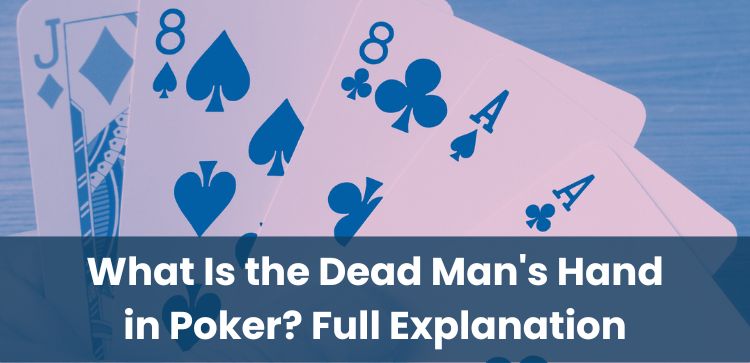
Many have heard the phrase “Dead Man’s Hand” but aren’t entirely sure what it refers to. It often turns up in films or around poker tables, usually mentioned with a sense of drama. The origin of the term, however, goes much further back.
In the sections below, you'll find what this phrase means in the context of poker, the story that gave it weight, the specific cards tied to it, and why it continues to be mentioned today. It isn’t an official part of the game’s rules, but it adds a layer of storytelling that players still enjoy.
Read on to learn more.
What Does the Dead Man’s Hand Mean in Poker?
Within poker circles, the “Dead Man’s Hand” refers to a specific combination of cards. It's not widely discussed in strategic terms, but people still bring it up from time to time.
It usually describes a certain two‑pair hand, although its significance doesn’t come from how strong or weak it might be. What really gives it staying power is the background attached to it—something that’s been retold for decades. In some formats, the same pairing of cards may still draw mention, even if the layout changes slightly.
But to grasp why this phrase became part of poker’s language, you need to go back to a specific event in the American West.
The Story Behind the Dead Man’s Hand
The tale begins with a well-known figure from the frontier era: Wild Bill Hickok. In the summer of 1876, Hickok was in a saloon in the town of Deadwood. He was taking part in a card game when he was shot from behind by a man named Jack McCall.
It’s said that Hickok normally avoided sitting with his back to the room, but on that particular day, he didn’t follow that instinct. What’s often repeated in accounts is what he was holding when he fell. That detail is where the hand gets its name—though how accurate those accounts are is still debated.
No one wrote down the exact cards at the time, so later versions vary. Still, the moment captured people’s attention, and the story began to spread in newspapers, books, and later, on film.
This moment—better known through legend than verified detail—helped popularise the nickname that would later be tied to a specific hand.
Why Is It Called the Dead Man’s Hand?
The phrase became linked to the hand Hickok was said to be holding when he was killed. As word of the event spread and the tale was retold, the nickname “Dead Man’s Hand” began to take shape.
Writers and storytellers started using the term, and eventually, it became part of the poker lexicon. It was a way to label a memorable event with a specific set of cards, even if those cards don’t carry any special meaning in the rules of the game.
So, what exactly were those cards? That’s where most people begin to recognise the term.
What Cards Make Up the Dead Man’s Hand?
The Dead Man’s Hand is most often described as two black aces and two black eights. More specifically: the ace of spades, ace of clubs, eight of spades, and eight of clubs.
Because the story tends to place Hickok at a five‑card draw table, some versions also mention a fifth card. What that card was is unclear—different sources have suggested everything from the queen of hearts to other options—but none are universally agreed upon. Most people focus on the two pairs alone.
In modern variants such as Texas Hold’em, players might still refer to this combination by the same name, even though the structure of the game means the suits or community cards can differ. The phrase sticks because of the story, not because of the layout.
Is the Dead Man’s Hand Considered Unlucky?
Some regard the hand with a sense of foreboding, purely because of how it entered poker lore. Others see it as a curious bit of history and nothing more. Whatever people may say about it, its impact on actual gameplay is limited.
Ultimately, its value depends on context—things like position, stack size, and how the rest of the board develops. Whether or not players talk about the hand in a certain way doesn’t change how it’s treated during play.
Beyond its use at the table, though, the hand has taken on a life of its own elsewhere.
Dead Man’s Hand in Modern Poker Culture
Today, the Dead Man’s Hand is a familiar reference among players, even if it doesn’t influence decisions. It comes up in conversation when the cards appear, often followed by a knowing smile or a quick story.
Away from the table, the hand is sometimes used in films, books, and artwork to evoke the Old West. It can be found in logos, tattoos, and other designs that play on its lasting image.
While the phrase carries no official status in the rules of any poker variant, its cultural presence continues. It serves as a reminder that poker isn’t just about maths and cards—it also carries the echoes of the people and stories that have shaped it over time.
If you choose to play poker, always do so with responsible gambling practices in mind and never wager more than you are willing to lose.
**The information provided in this blog is intended for educational purposes and should not be construed as betting advice or a guarantee of success. Always gamble responsibly.
